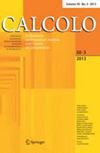粘弹性杆和板的非线性 Volterra 积分微分方程的数值分析
IF 1.3
2区 数学
Q1 MATHEMATICS
引用次数: 0
摘要
这项研究考虑了非线性 Volterra 积分微分方程的数值分析,这些方程产生于各向同性粘弹性杆和板的理论等。通过拉普拉斯变换得出了核及其导数的新特性,并证明了解的正则性。然后,我们应用 Crank-Nicolson 方法和二阶卷积正交规则建立了离散时间方案,并利用能量论证分析了所提方案的稳定性和收敛性。我们还进行了数值实验来证实理论结论。本文章由计算机程序翻译,如有差异,请以英文原文为准。
Numerical analysis of nonlinear Volterra integrodifferential equations for viscoelastic rods and plates
This work considers the numerical analysis of nonlinear Volterra integrodifferential equations that arise from, e.g., the theory of isotropic viscoelastic rods and plates. Novel properties of the kernel and its derivatives are derived via the Laplace transform, and the regularity of the solutions is proved. Then we apply the Crank–Nicolson method and the second-order convolution quadrature rule to develop the discrete-in-time scheme, and the energy argument is employed to analyze the stability and convergence of the proposed scheme. Numerical experiments are performed to substantiate the theoretical findings.
求助全文
通过发布文献求助,成功后即可免费获取论文全文。
去求助
来源期刊

Calcolo
数学-数学
CiteScore
2.40
自引率
11.80%
发文量
36
审稿时长
>12 weeks
期刊介绍:
Calcolo is a quarterly of the Italian National Research Council, under the direction of the Institute for Informatics and Telematics in Pisa. Calcolo publishes original contributions in English on Numerical Analysis and its Applications, and on the Theory of Computation.
The main focus of the journal is on Numerical Linear Algebra, Approximation Theory and its Applications, Numerical Solution of Differential and Integral Equations, Computational Complexity, Algorithmics, Mathematical Aspects of Computer Science, Optimization Theory.
Expository papers will also appear from time to time as an introduction to emerging topics in one of the above mentioned fields. There will be a "Report" section, with abstracts of PhD Theses, news and reports from conferences and book reviews. All submissions will be carefully refereed.
 求助内容:
求助内容: 应助结果提醒方式:
应助结果提醒方式:


